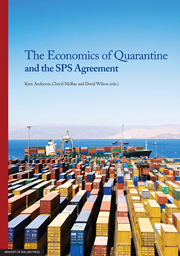Book contents
- Frontmatter
- Contents
- List of tables, figures and boxes
- Acronyms
- Preface
- List of contributors
- 1 Introduction
- PART I The multilateral rules under WTO
- PART II The ‘appropriate level of protection’
- 6 Appropriate level of protection: a European perspective
- 7 Appropriate level of protection: an Australian perspective
- 8 Appropriate level of protection: a New Zealand perspective
- 9 Beyond iso-risk to include benefits under the SPS Agreement
- 10 Integrating import risk and trade benefit analysis
- PART III Adding more economics to risk analysis
- PART IV Specific health and environmental risks from trade
- PART V Conclusion
- APPENDIX The legal text of the SPS Agreement
7 - Appropriate level of protection: an Australian perspective
from PART II - The ‘appropriate level of protection’
Published online by Cambridge University Press: 05 June 2013
- Frontmatter
- Contents
- List of tables, figures and boxes
- Acronyms
- Preface
- List of contributors
- 1 Introduction
- PART I The multilateral rules under WTO
- PART II The ‘appropriate level of protection’
- 6 Appropriate level of protection: a European perspective
- 7 Appropriate level of protection: an Australian perspective
- 8 Appropriate level of protection: a New Zealand perspective
- 9 Beyond iso-risk to include benefits under the SPS Agreement
- 10 Integrating import risk and trade benefit analysis
- PART III Adding more economics to risk analysis
- PART IV Specific health and environmental risks from trade
- PART V Conclusion
- APPENDIX The legal text of the SPS Agreement
Summary
The appropriate level of sanitary or phytosanitary protection, otherwise referred to as the acceptable level of risk, is defined in the WTO Agreement on the Application of Sanitary and Phytosanitary Measures as the “level of protection deemed appropriate by the [WTO] Member establishing a sanitary or phytosanitary measure to protect human, animal or plant life or health within its territory.” It is well established that the determination of its appropriate level of protection is a matter in which the national sovereignty of a Member prevails, consistent with Article 2.1 of the Agreement which says that “Members have the right to take sanitary and phytosanitary measures necessary for the protection of human, animal or plant life or health.” However the SPS Agreement requires that “Members should, when determining the appropriate level of sanitary or phytosanitary protection, take into account the objective of minimizing negative trade effects” (Article 5.4).
Members are also obliged, under Article 5.5 of the Agreement, to “avoid arbitrary or unjustifiable distinctions in the levels [considered] to be appropriate in different situations, if such distinctions result in discrimination or a disguised restriction as international trade.” No guidance is provided by the Agreement on what might constitute an arbitrary or justifiable distinction or as to what kind of justification might be offered. However the statement in the same paragraph that in developing guidelines to further the practical implementation of this provision, the SPS Committee “shall take into account all relevant factors including the exceptional character of human health risks to which people voluntarily expose themselves” strongly implies that these risks might justifiably be managed in a different way from other sanitary risks.
- Type
- Chapter
- Information
- The Economics of Quarantine and the SPS Agreement , pp. 132 - 140Publisher: The University of Adelaide PressPrint publication year: 2012

